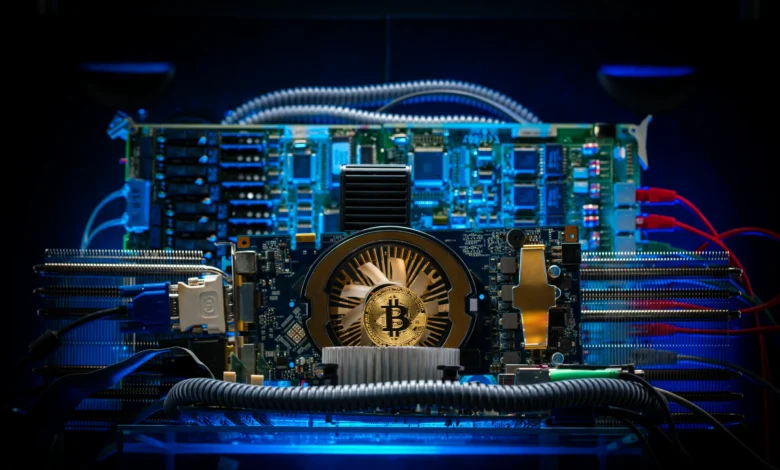Fintechzoom.com crypto mining Guide: How It Works in 2025

Cryptocurrency mining sounds like a gold rush for the digital age—computers humming, churning out new coins, and maybe, just maybe, making you rich. But in 2025, mining is a complex beast, blending cutting-edge tech, hefty costs, and big questions about profitability and sustainability. Whether you’re dreaming of setting up a Bitcoin mining rig in your garage or just curious about how new coins are created, understanding mining is key to grasping the crypto world. At Fintechzoom.com, we’re diving into what cryptocurrency mining is, how it works, the hardware and costs involved, its rewards and risks, and whether it’s still a worthwhile venture in today’s market. Let’s break it down and see if mining is your ticket to crypto success.
Table of contents
What Is Cryptocurrency Mining?
Cryptocurrency mining is the process of validating transactions on a blockchain network to earn rewards in the form of newly minted coins. Think of it as the engine that keeps blockchains like Bitcoin running. Miners use powerful computers to solve complex mathematical puzzles, which confirm transactions and add them to the blockchain—a decentralized, tamper-proof ledger. Once a puzzle is solved, the miner broadcasts the solution to the network, and if verified, they’re rewarded with coins. For Bitcoin, this reward was 3.125 BTC per block in 2025, worth about $250,000 at $80,000 per Bitcoin. Mining secures the network, prevents double-spending, and introduces new coins, but it’s resource-intensive, requiring significant computing power and energy.
How Does Crypto Mining Work?
Mining starts with a transaction—like sending Bitcoin from one wallet to another. These transactions are grouped into a block, but before the block joins the blockchain, miners must solve a cryptographic puzzle, a process called proof-of-work. This involves guessing a number (a nonce) that, when hashed with the block’s data, produces a specific result. It’s like cracking a code through trial and error, requiring millions of calculations per second. The first miner to solve it adds the block and claims the reward. In 2025, Bitcoin’s mining difficulty is at an all-time high, adjusted every two weeks to keep block times around 10 minutes. Other coins, like Ethereum, now use proof-of-stake, where validators stake coins instead of computing, but Bitcoin and many altcoins stick with mining.
The Hardware You Need for Mining
Mining isn’t something you can do with your old laptop anymore. Bitcoin mining in 2025 relies on specialized hardware called ASICs (Application-Specific Integrated Circuits), like the Bitmain Antminer S21, which delivers 200 terahashes per second. These machines cost $2,000–$5,000 each and are designed solely for mining specific coins. For altcoins like Monero or Zcash, high-end GPUs (graphics processing units), like NVIDIA’s RTX 4090, are still viable, costing $1,500–$2,000. You’ll also need a reliable power supply, cooling systems to prevent overheating, and a stable internet connection. Posts on X highlight home miners using GPU rigs for smaller coins, but large-scale operations dominate Bitcoin, with mining farms housing thousands of ASICs in regions with cheap electricity, like Texas or Iceland.
The Costs of Crypto Mining
Mining isn’t cheap. Hardware is the first hurdle—a single Antminer S21 costs $3,000, and a competitive setup might need 10 units. Electricity is the biggest ongoing expense; mining Bitcoin consumes about 1,500 watts per ASIC, and at $0.10 per kilowatt-hour, a single rig’s monthly power bill can hit $300. Cooling and maintenance add more costs, especially in warmer climates. In 2025, global electricity prices vary—miners in Venezuela pay $0.02 per kWh, while those in Europe face $0.20 or more. Internet and facility costs (for large setups) can push monthly expenses into the thousands. Fintechzoom.com’s mining calculators help you estimate costs based on your location and setup, so you can crunch the numbers before jumping in.
Is Crypto Mining Profitable in 2025?
Profitability depends on several factors: coin price, mining difficulty, hardware efficiency, and electricity costs. In 2025, Bitcoin’s $80,000 price makes mining lucrative for those with access to cheap power—miners in Texas, using renewable energy at $0.05 per kWh, can earn $1,000 monthly per ASIC after costs. However, high difficulty and competition mean small-scale miners struggle unless mining altcoins like Ravencoin, which have lower barriers. The 2024 Bitcoin halving cut rewards, squeezing margins for inefficient setups. X discussions show mixed sentiment—some miners report 20% returns, while others lament rising costs. Using efficient hardware and joining mining pools, where miners share resources and rewards, can boost profitability, but it’s no get-rich-quick scheme.
Environmental Impact of Mining
Mining’s energy hunger has long been a lightning rod for criticism. Bitcoin’s network consumes about 150 terawatt-hours annually, comparable to a small country. In 2025, 40% of Bitcoin mining uses renewables, up from 20% in 2022, driven by pressure from environmental groups and cheaper solar and wind power. Regions like Quebec and Iceland, with abundant hydropower, are mining hubs. Ethereum’s 2022 shift to proof-of-stake cut its energy use by 99%, setting a model for greener blockchains. Altcoins like Chia use proof-of-space, leveraging storage instead of computing power. Still, critics argue mining’s carbon footprint remains too high. Miners adopting renewables or relocating to low-cost, eco-friendly regions can align profitability with sustainability.
Risks and Challenges of Mining
Mining isn’t without pitfalls. Volatility can erode profits—if Bitcoin drops 20%, as it did in March 2025, revenue takes a hit. Rising mining difficulty, adjusted every two weeks, forces constant hardware upgrades. Regulatory risks loom—some countries, like China, ban mining outright, while others impose energy taxes. Security is another concern; mining pools can be hacked, and physical setups risk theft or damage. X posts highlight horror stories of miners losing thousands to power outages or scams. Finally, the upfront investment—$10,000 or more for a small rig—means you need deep pockets and patience. Researching costs and risks via Fintechzoom.com is crucial before starting.
Getting Started with Crypto Mining
Ready to mine? Start small and smart. Research coins—Bitcoin for stability, or altcoins like Monero for lower entry barriers. Calculate costs using Fintechzoom.com’s tools, factoring in hardware, electricity, and cooling. Buy efficient hardware, like an Antminer for Bitcoin or GPUs for altcoins, and consider joining a mining pool like Slush Pool to share rewards. Choose a location with cheap, ideally renewable, energy—$0.05 per kWh or less is ideal. Set up secure software, monitor performance, and stay updated on market trends via X or news. Mining isn’t for everyone, but with the right setup, it can be a rewarding venture.
Conclusion
Cryptocurrency mining in 2025 is a high-stakes game, blending tech, finance, and strategy. It powers blockchains like Bitcoin, rewarding miners with new coins, but demands hefty investments in hardware, power, and know-how. While profitability is possible—especially with cheap electricity and efficient rigs—volatility, competition, and environmental concerns pose challenges. Fintechzoom.com offers calculators, guides, and insights to help you decide if mining is worth it. Whether you’re eyeing Bitcoin’s big rewards or exploring altcoin opportunities, mining is a fascinating piece of the crypto puzzle—dive in with eyes wide open.
FAQs
What is cryptocurrency mining?
Crypto mining involves using computers to solve complex puzzles to validate blockchain transactions, earning rewards in coins like Bitcoin. It secures the network and creates new coins.
Is crypto mining profitable in 2025?
Profitability depends on coin prices, electricity costs, and hardware efficiency. Bitcoin miners with cheap power ($0.05/kWh) can earn $1,000 monthly per rig, but high costs challenge small miners.
What hardware do I need for mining?
Bitcoin requires ASICs like the Bitmain Antminer S21 ($3,000), while altcoins like Monero use GPUs like NVIDIA RTX 4090 ($1,500). Cooling and power supplies are also essential.
How does mining impact the environment?
Bitcoin mining uses 150 TWh annually, but 40% comes from renewables in 2025. Greener options like Ethereum’s proof-of-stake or Chia’s proof-of-space reduce environmental impact.
Can beginners start crypto mining?
Yes, but start small with altcoins or mining pools to lower costs. Use Fintechzoom.com’s calculators to estimate expenses and research hardware and energy options carefully.
What are the risks of crypto mining?
Risks include price volatility, high electricity costs, regulatory bans, and hardware failures. Stay informed via Fintechzoom.com and secure your setup to minimize losses.





